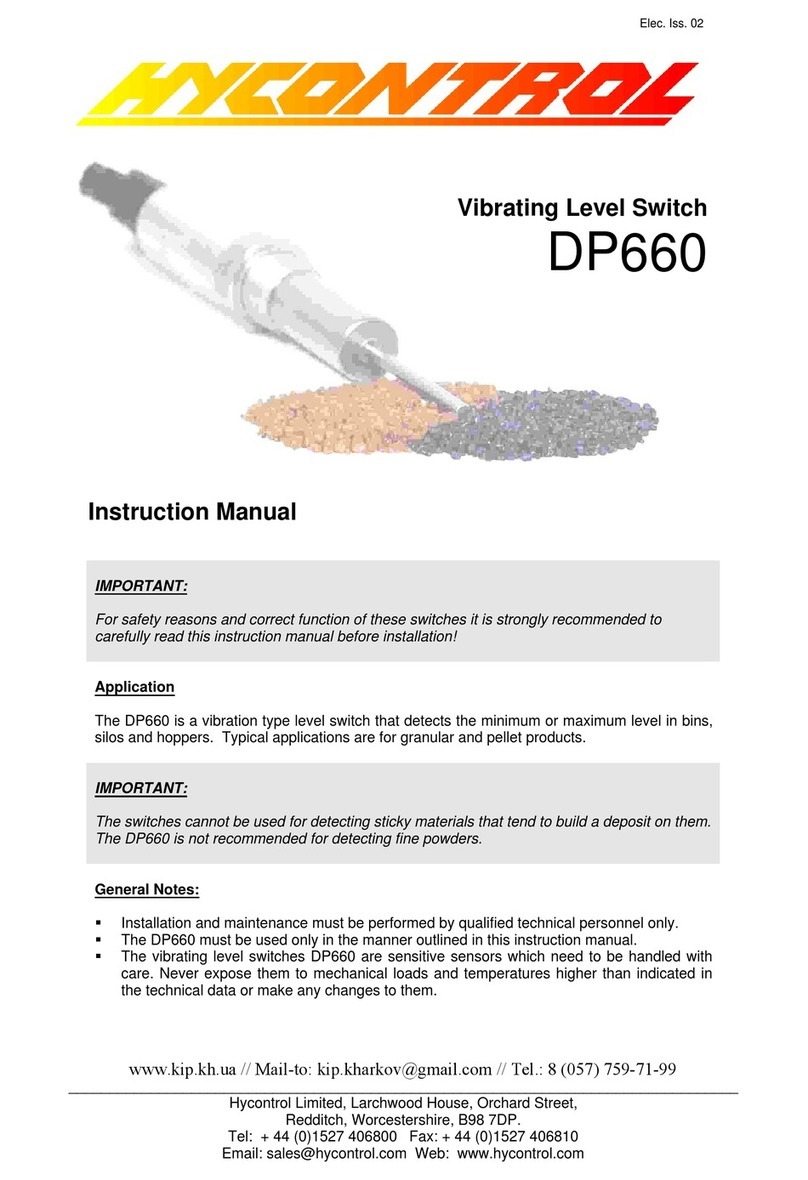Application
The DP600/630/650 SERIES are vibration-type level control
instruments that detect the minimum or maximum level in bins, silos
and hoppers, filled with grained materials (bulk solids). Typical product
applications are plastic granules, all kinds of pellets, corn etc.
IMPORTANT:
The instruments cannot be used for detecting materials which are sticky
and tend to build a deposit on the vibrating rod!
General Notes:
▪Installation and maintenance must be performed by qualified
technical personnel only.
▪DP600/630/650 must be used only in the manner outlined in this
instruction manual.
▪Never expose these instruments to mechanical loads and
temperatures higher than indicated in the technical data. Do not
make any changes on these instruments.
Models
▪DP600: standard model, insertion length 157mm
▪DP630: model with tube extension, insertion length max. 1.0m
▪DP650: model with cable extension, insertion length max. 4.0m
Function
The signal from the electronic circuit excites the rod of the instrument to
vibrate at its resonance frequency of approx. 460 Hz. When material
covers the rod of the probe, the vibration stops. This is sensed by the
electronic circuitry which forces its output to switch. When the rod gets
uncovered, the vibration will restart and the output switches back.
Technical Data
General:
Enclosure: Die-cast aluminium (powder coated RAL 2008)
Protection IP66
(IP65 for remote electronics installation)
1 cable gland M16x1.5 (option: 2 cable glands)
Suitable for cable diameters 4.5 to 10 mm
Probe: Stainless steel 1.4301 / AISI 304
Resonance frequency approx. 460 Hz
Extension cable DP650: PU sheathed
Connection: Thread 1”BSPT (EN 10226) or 1”NPT
Time Delay 1 second from stop of vibration
2 to 5 seconds for start of vibration
Indication Relay: red LED on PCB
2-wire: green LED on PCB
Power supply: yellow LED on PCB
(relay version only)
Density of material
to be monitored: min. 20 g / litre
Max. load upon the
end of the rod: 80 N
Max. load on
cable DP650: 200 kg
Max. pressure inside bin: 10 bar
(0.8 … 1.1 bar for models with ATEX or UKEX approval)
Safety: protection class I / installation category III /
pollution degree 2 / altitude max. 2000m
Electronics:
Wide range version with relay output
Power Supply: 20...250V AC/DC
Relay Output: One volt free change over contact (SPDT)
Max. switching voltage: 250V AC
Max. switching current: 5A (NO-contact),
3A (NC-contact)
Max. switching power:1250VA @ cos = 1,
150 Watt for DC
Power Consumption: 3VA
2-Wire DC-Version with 8/16mA current output
Power Supply: 20…30V DC
Current: Max-Alarm FH: 8mA (probe vibrating)
16mA (probe damped)
Min-Alarm FL: 8mA (probe damped)
16mA (probe vibrating)
Note: 2-Wire version is NOT ATEX or UKEX approved.
For 2-Wire models without approval, power supply and signal conversion
can be performed by any suitable DC supply with current sensing capability.
In this case the maximum technical data have to be considered.
Power consumption: ≤0.5W
Max. wire diameter for power supply and output signal: 1.5 mm²
Max. allowed ambient and process temperature range:
Ambient temperature for electronics: -20°C ... + 60°C
Ambient temperatures depend on process temperatures as follows:
Process temperature for standard probe: -20°C ... + 80°C
Process temperature for probe HT: -20°C ... + 150°C
(special model for high temperatures)
Process temperature for probe DP650: -20°C ... + 70°C
CE Conformity
The level switches DP600/630/650 meet the requirements of the
following EU regulations:
▪ EU EMC-directive 2014/30/EU
▪ EU Low Voltage Directive 2014/35/EU
▪ ROHS2 2011/65/EU
UKCA Conformity
The level switches DP600/630/650 meet the requirements of the
following UK regulations:
▪ UK Electro magnetic compatibility Regulations SI 2016 No. 1091
▪ UK Electrical Equipment (Safety) regulations SI 2016 No. 1101
▪Restriction of the Use of Certain Hazardous Substances in
Electrical and Electronic Equipment Regulations
SI 2012 No. 3032 (as amended)
The following standards are applied:
▪ EN 61326-1
▪ EN 61010 -1
▪ EN 50581


























